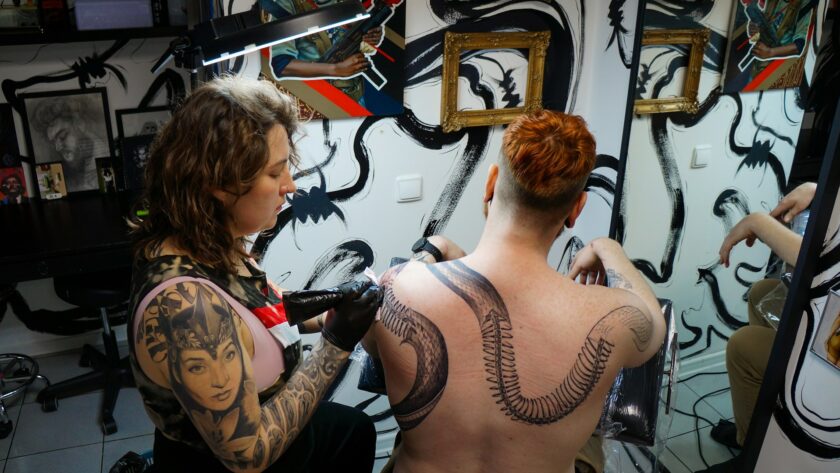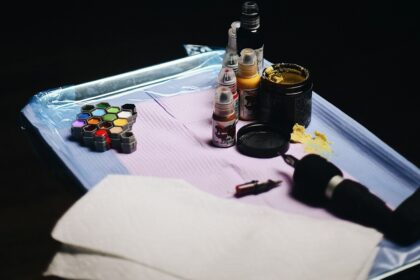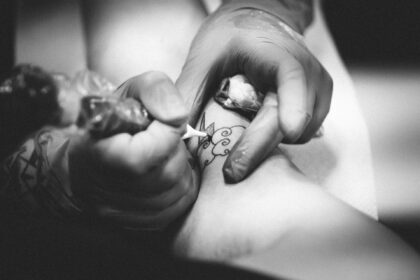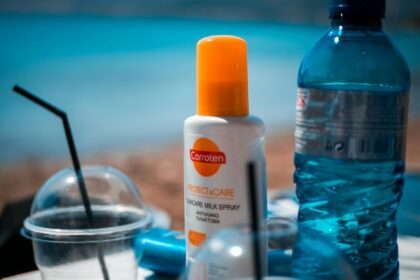When considering a tattoo, one of the most frequently asked questions is, “How much will it hurt?” Pain is an inevitable part of the tattoo process, but understanding which areas are the most and least painful can help ease your anxiety. This comprehensive tattoo pain chart outlines what you can expect based on the body part. Knowing what you’re getting into helps you plan, especially if it’s your first time under the needle.
Different parts of your body experience different pain levels due to factors like nerve concentration and skin thickness. Let’s dive into which areas are generally considered to be the most painful, and which might surprise you with their relative ease.
Least Painful Tattoo Spots
Choosing a tattoo placement in a less sensitive area can significantly reduce discomfort. Generally, places with more flesh or muscle, and fewer nerve endings, will cause less pain. Some of the least painful tattoo spots include the outer arms, thighs, and upper back. These areas have thicker skin and fewer nerve endings compared to others, making them ideal for people with a low pain tolerance.
Additionally, larger, fleshy areas like the buttocks or outer thigh are not only less painful, but they also offer enough space for more intricate designs. This makes them a great choice for people who want elaborate artwork without the intense pain. For those wondering, starting with smaller tattoos in these areas will help ease you into the experience, which is ideal for beginners. The tattoo pain chart supports the notion that the more muscle or fat, the less painful the tattoo process will be.
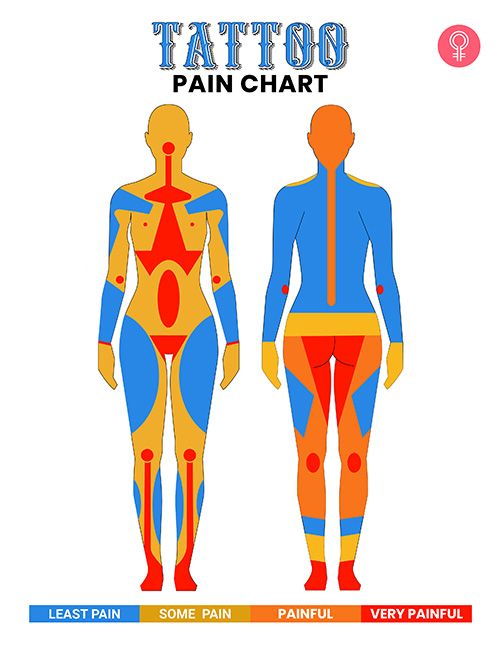
Image source: https://pinterest.com/pin/578149670929254216/
Most Painful Tattoo Areas
On the opposite end of the spectrum, certain body parts are notorious for their intense pain levels. Areas with less flesh and more bone, such as the ribs, spine, and hands, are considered the most painful tattoo zones. This is due to the thinness of the skin in these regions and the higher concentration of nerve endings. Tattoo pain can be particularly intense on the ribs, as every breath can shift the needle slightly, causing more discomfort.
Hands and feet also fall into this high-pain category due to their proximity to bone and the fact that these areas are used constantly, making the healing process longer and more uncomfortable. The tattoo pain chart emphasizes that getting inked in these spots is not for the faint of heart, but the results can be stunning. If you’re determined to get a tattoo in one of these areas, mentally and physically preparing for the pain can help you endure the session.
| Body Part | Pain Level | Explanation |
|---|---|---|
| Outer Arm (Upper) | Low | The outer arm has thick skin, more muscle, and fewer nerve endings, making it one of the least painful areas to get tattooed. |
| Thigh (Outer) | Low | The outer thigh is fleshy and has fewer nerve endings, providing a larger canvas with minimal pain. Ideal for beginners or larger tattoos. |
| Upper Back | Low to Medium | The upper back is generally low-pain, but closer to the spine, pain levels may increase due to bone proximity. |
| Forearm | Low | This area has plenty of muscle and a moderate number of nerve endings, making it a good choice for a less painful tattoo experience. |
| Calves | Low to Medium | Calves are fleshy and have thicker skin, but pain can increase near the back of the knees or where nerves are more concentrated. |
| Chest (Pectorals) | Medium | The chest can vary; areas with more muscle are tolerable, but close to the sternum and collarbones can be more painful due to thinner skin and bones. |
| Ankle | High | Tattooing over the ankle bones is highly painful because of the thin skin and direct contact with bone. |
| Ribs | High | Rib tattoos are known for being extremely painful due to thin skin, fewer muscle layers, and the constant movement of the ribcage during breathing. |
| Hands/Fingers | High | Thin skin, numerous nerve endings, and proximity to bones make tattoos on the hands and fingers very painful, with extended healing times. |
| Feet (Tops) | High | Like hands, the feet have thin skin and many nerve endings, making tattoos here very painful. The bone proximity also adds to the discomfort. |
| Spine | Very High | The spine is one of the most painful areas to tattoo due to its lack of muscle, minimal fat, and the direct contact of the needle with bone and nerve clusters. |
| Armpit | Very High | The armpit area is highly sensitive with numerous nerve endings, making it one of the most painful spots to get a tattoo. |
| Neck (Front/Throat) | Very High | Thin skin, exposed nerves, and the inability to avoid movements like swallowing make the neck, especially the front, very sensitive to pain. |
Managing Tattoo Pain Effectively
While getting a tattoo will always involve some level of pain, there are several ways to manage it effectively. One of the most common methods is using numbing creams, which many tattoo artists offer or recommend. These creams can help reduce the initial sting and make the process more bearable. Hydration and eating a good meal before your appointment can also make a difference in how your body responds to the tattoo pain.

Image source: https://giphy.com/gifs/wolfentertainment-svu-law-and-order-svu21-SXToz5KYIOG7aOXngt
Additionally, breathing techniques can help you manage discomfort during the session. Slow, deep breaths can calm your nerves and reduce your body’s pain response. After the session, proper aftercare is crucial. Swelling, redness, and mild pain are common after-effects, but following your tattoo artist’s care instructions can minimize these symptoms. Healing is just as important as the inking process, so investing in high-quality aftercare products will ensure your tattoo heals beautifully with minimal discomfort.
Tattoo Pain Chart: Explained by Body Placement (Male and Female)
Our tattoo pain chart ranks different body areas on a scale from 1 to 10, but how exactly are these scores determined? We’ve surveyed hundreds of people—both male and female—who’ve undergone tattoo sessions, collecting real experiences and insights on how much pain they felt based on the tattoo’s location. While these averages offer valuable insights, remember that pain is subjective, and your personal experience could differ. To better understand what impacts your pain levels, check out our section below on the factors that affect tattoo pain.
Rib Cage: One of the Most Painful Spots for a Tattoo
The rib cage stands out as one of the most painful areas for tattoos. Both men and women consistently rate this spot as extremely painful. This is primarily due to the thin skin over the ribs, which offers little padding between the skin and bone. When the tattoo needle penetrates, it directly stimulates sensitive nerve endings, intensifying the pain. The constant movement of the ribs as you breathe also makes tattooing here a greater challenge for the artist, adding to your discomfort. Because of these factors, we rate the rib cage a 9/10 in terms of pain for both genders.
Tattoo Pain for Women: Ribs and Breasts
For women, the rib cage is especially sensitive not only because of its thin skin but also due to its proximity to the breast area, which is also quite painful to tattoo. The breast area has soft, delicate skin with a lot of nerve endings, making it highly sensitive to any form of skin trauma. Many women have reported that tattoos near the ribs or breasts can be overwhelming, requiring more frequent breaks to manage the pain.
Tattoo Pain for Men: Ribs
Men also experience intense pain in the rib area, regardless of body type. Whether you’re muscular, lean, or have more body fat, the rib tattoo pain remains consistent because the area lacks muscle or fat to cushion the impact of the needle. Even heavily muscled men find the rib cage uncomfortable due to the bones being so close to the skin. Many people, regardless of gender, rate this area among the most painful for tattoos, making it a challenging but rewarding choice for body art.
By understanding these placement-specific pain levels, you can prepare both mentally and physically for your tattoo experience.
Armpits: A Painful Area to Tattoo
The armpit is widely regarded as the second most painful area to get tattooed, and for good reason. Many tattoo artists actually advise against tattooing this area due to the high concentration of nerves and the sensitivity of the skin. Additionally, the armpit is close to breast glands and has delicate, thin skin that makes tattooing especially painful. Because of the intense sensitivity, we’ve rated the armpit tattoo pain a 10/10 for both men and women.
There is often a debate among those with experience about whether the armpits or the rib cage cause more pain. While both areas are extremely painful, some say that armpit tattoos hurt even more, particularly because of how sensitive this body part is to external stimuli. This makes the armpit one of the hardest areas to endure during a tattoo session.
Armpit Tattoos for Women
For women, the armpit can be even more challenging if the tattoo design spreads toward the breast or side boob area, which is already highly sensitive. The thinness of the skin and proximity to important nerve pathways make this area particularly uncomfortable. Many women report that tattoos in this region are excruciating, requiring frequent breaks throughout the session.
Armpit Tattoos for Men
Although men may not experience the same proximity to breast tissue, they also find armpit tattoos to be incredibly painful. If the tattoo extends down to the chest or side body, the pain intensity remains extremely high. No matter your gender, the armpit is a sensitive region that many agree is nearly impossible to endure without significant discomfort.
Overall, the armpit is not a recommended tattoo spot unless you are well-prepared for extreme pain. The tattoo pain chart consistently ranks this area as one of the most intense.
Shin and Ankle Tattoos: High Pain Levels Due to Thin Skin and Bone Exposure
Getting a tattoo on the shin or ankle bones is known to be one of the most painful experiences. Both the shinbones and ankles are covered with a very thin layer of skin, which offers little protection against the tattoo needle. As a result, when the needle hits, it comes into direct contact with the bone, making the process particularly uncomfortable. Both men and women report high pain levels when getting tattooed in these areas, though men may experience slightly less pain than women. However, the difference is minimal, as the shin and ankle tattoo pain is universally intense due to the area’s lack of cushioning.
Tattoo Pain for Women: Shins and Ankles
For women, tattooing over the shinbones and ankles can be especially painful. However, some women who are accustomed to regular leg waxing or epilating may have a slightly higher tolerance for discomfort in this region. Even so, the ankles and shins are incredibly sensitive, and the pain can feel overwhelming, particularly when tattooing the back of the ankles. On the bright side, the area next to the shinbone, where there is more flesh, offers a bit of relief compared to the thin, bony sections. If you’re getting a full leg tattoo, this area will feel less severe in contrast.
Tattoo Pain for Men: Shins and Ankles
Men also report high pain levels when getting tattoos on the shinbones and ankles. Although some men may find the pain on the rear of the ankle slightly more tolerable than women, the overall discomfort remains significant. The lack of muscle or fat in these regions means that the needle hits close to the bone, causing a sharp, severe pain that most people struggle to endure. The shin and ankle areas rank very high on the tattoo pain chart, making them challenging locations for those with low pain tolerance.
In summary, tattoos on the shinbones and ankles are rated among the most painful due to the thin skin and direct contact with bone. Whether you’re male or female, expect these areas to cause considerable discomfort during the tattoo process.
Chest and Breast Tattoos: High Pain Levels for Both Men and Women
Tattooing the chest or breasts is known for causing significant discomfort, regardless of gender. Both men and women report high pain levels, although women generally rate the experience as more painful. This difference is largely due to the sensitive nature of breast tissue. For men, the pain tends to be around an 8/10, while for women, the pain often reaches a 9/10. This is because the breasts contain more tender skin and nerve endings, particularly around the nipples, making the area extremely sensitive to the tattoo needle.
Tattoo Pain for Women: Chest and Breasts
For women, tattoos on the breasts are especially painful because of the soft, fleshy tissue that lacks the protective layers of muscle or fat found elsewhere. The nipples are the most sensitive area, often making this part of the chest tattoo extremely uncomfortable. The increased sensitivity is compounded by the fact that the breasts are tender and have a higher concentration of nerve endings. While some areas of the chest might feel less intense, the overall experience is far from easy and requires mental preparation.
Tattoo Pain for Men: Chest
Men experience severe pain when tattooing the chest as well, although the level of discomfort can vary based on their body type. Men with more muscle mass in the chest might find the pain slightly more tolerable, as there is more tissue between the skin and bones. However, the sternum and areas closer to the collarbones tend to be very painful due to their proximity to bone. While men’s chest tattoos generally receive a pain rating of around 8/10, it’s still an intense area that requires endurance.
In summary, both men and women will experience considerable pain when getting a chest or breast tattoo, with breast tattoos generally being more painful due to the tenderness of the area. This region ranks high on the tattoo pain chart and is not for the faint of heart, regardless of gender.
